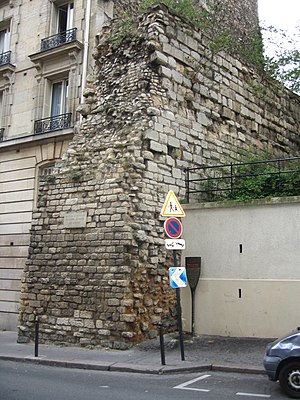First up, the Arènes de Lutèce, one of the few remains of Roman Paris (then called Lutèce in French or Lutetia in Latin). The other is the Thermes de Cluny, Roman baths which are part of the Musée du Moyen Age. I've been there as well, in 2002 with my mother, grandmother and aunt. The arena is hard to find. Even knowing where it was located and having a map, it was difficult to find, hidden away on a side street of the Latin Quarter.

A model of the arena, photo from Wikipedia.
The amphitheater could seat up to 15,000 people and was used for gladiatorial combat as well as circus shows and theatrical productions on its stage. It was built in the first century AD and is considered to be the longest Roman amphitheater of its kind.
The arena sacked during the barbaric invasions (280 AD) and stone was used to reinforce the Ile de Cite's defenses. It then became a cemetary and was completely filled in when the Wall of Phillippe August was constructed (1210 AD). It was lost until Theodore Vaquer re-discovered it during the building of the Rue Monge between 1860–1869. A preservation committee was started to save the archaeological treasure. One third of the arena was uncovered when the Couvent des Filles de Jésus-Christ was demolished in 1883. Funds were set aside by the Municipal Council to restore the arena and establish it was a public square and as such it opened in 1896. There was more excavation and restoration towards the end of World War I.

Me at the Arenas de Lutece. Photo by me.

How the arena looks today, photo from Wikipedia. As you can see, a portion of the arena was lost the buildings along rue Monge. You can still see the stage as well as the grilled cages in the wall that held wild animals. The bleachers aren't original and its believed that 41 arched openings punctuated the facade.
I also saw remnants of the Wall of Philip Augustus, mentioned above, the oldest city wall of Paris for which we know its layout. Although it was partially integrated into buildings, more traces remain than of later fortifications which were destroyed and replaced with the Grands Boulevards.

Portion along the rue Clovis. Photo from Wikipedia, but I took a very similar one when I was there.
Next up, the Eiffel Tower! Or La Tour Eiffel. Built in 1889, it is the tallest building in Paris and the most visited paid monument in the world. Architecturally speaking, it is a puddle iron lattice tower.

Photo from Wikipedia.

Up close to the Eiffel Tower. Photo by me.

Look Mom! I'm on top of the Eiffel Tower! Photo by a friend.
And now for the Arc de Triomphe. It is in the center of the Place Charles de Gaulle, originally named Place de l'Etoile for the design the streets form, at the west end of the Champs-Elysees. It was built to honor those that fought and died for France during the Revolution and during the Napoleonic Wars. Beneath its vault is the Tomb of the Unknown Soldier from the First World War. It is one of the largest triumphal arches and a biplane has been flown through its arch.

Me at the Arc de Triomphe. Photo by a friend.

Avenues radiate out from the Arc de Triomphe in a star like shape.
The Place de la Concorde is the largest square in Paris and can be found at the eastern end of the Champs-Elysees, opposite the Arc de Triomphe. The square began its life in 1755 as Place Louis XV and it showcased an equestrian statue of the king. Two identical buildings were constructed at the north end, separated by the rue Royale. One houses the French Naval Ministry while the other hosts the Hotel de Crillon, a famous luxury hotel.
During the French Revolution, the king's statue was torn down and the square was renamed Place de la Revolution. A guillotine was constructed and it was here that King Louis XVI was executed in 1793. Numerous other important and famous people were executed here as well, including the Queen. In 1795, the guillotine was removed and the square renamed Place de la Concorde.

Me at Place de la Concorde. In the background is the Obelisk of Luxor, which originally marked the entrance to the Luxor Temple. A gift from Egypt, the obelisk was placed in the center of the square in 1836, where the guillotine once stood.
And finally, a nod to my train obsession: a photo of the Cardinal Lemoine metro stop, the closest stop to my hotel. It was on line 10 of the Metro.








